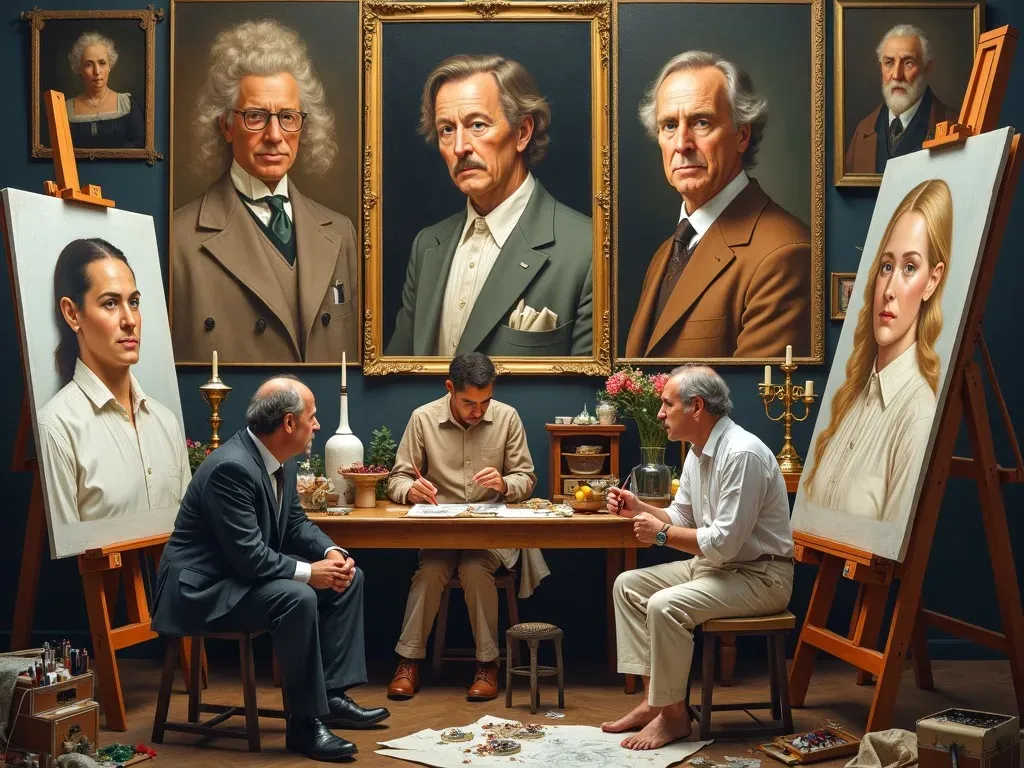Portraitists are renowned artists who specialize in creating remarkable likenesses of individuals through various mediums, predominantly painting. Their craft transcends mere visual representation; it encapsulates emotion, personality, and context within a single frame. Throughout history, the contributions of famous portraitists have not only shaped the aesthetics of portrait art but also influenced cultural narratives across generations. Below is an exploration into the world of famous portrait artists who have left indelible marks on art history.
Iconic Famous Portrait Artists
1. Leonardo da Vinci (1452–1519)
Leonardo da Vinci, often hailed as the epitome of a Renaissance man, is most recognized for his masterpieces such as the Mona Lisa and The Last Supper. His ability to capture the subtleties of human expression through meticulous detail and innovative Techniques like sfumato revolutionized portrait painting.
-
Famous Works:
- Mona Lisa (1503)
- Saint John the Baptist (1513)
2. John Singer Sargent (1856–1925)
An American expatriate artist, John Singer Sargent is widely celebrated for his stunning portraits characterized by their exquisite brushwork and the ability to convey the personalities of his subjects. His work often reflects the opulence of the era he painted in.
-
Notable Portraits:
- Portrait of Madame X (1884)
- Lady Agnew of Lochnaw (1892)
3. Rembrandt van Rijn (1606–1669)
As a leading figure of the Dutch Golden Age, Rembrandt’s portraits are distinguished by their deep empathy and profound psychological insight. He explored light and shadow in innovative ways, dramatically infusing life into his subjects.
-
Prominent Paintings:
- Self-Portrait with Two Circles (1665)
- The Night Watch (1642)
4. Frida Kahlo (1907–1954)
Frida Kahlo’s self-portraits are renowned for their vivid colors and exploration of identity, postcolonialism, and gender. Kahlo’s distinct style and deeply personal themes have made her an icon in modern art history.
-
Emblematic Works:
- Self-Portrait with Thorn Necklace and Hummingbird (1940)
- The Two Fridas (1939)
| Artist | Notable Work | Year | Style |
|---|---|---|---|
| Leonardo da Vinci | Mona Lisa | 1503 | High Renaissance |
| John Singer Sargent | Portrait of Madame X | 1884 | American Impression |
| Rembrandt van Rijn | Self-Portrait with Two Circles | 1665 | Baroque |
| Frida Kahlo | Self-Portrait with Thorn Necklace | 1940 | Surrealism |
5. Gustav Klimt (1862–1918)
Famous for his decorative and symbolic style, Gustav Klimt’s portraits often explore themes of love, femininity, and mortality. His iconic portrait, The Kiss, showcases his style through intricate patterns and golden motifs.
-
Key Works:
- Portrait of Adele Bloch-Bauer I (1907)
- The Kiss (1907-1908)
6. Chuck Close (1940–2021)
Renowned for his large-scale, hyper-realistic portraits, Chuck Close revolutionized contemporary portraiture with his unique grid technique, which allowed him to achieve unprecedented detail in his works.
-
Famed Creations:
- Big Self-Portrait (1967-1968)
- Lucas (1986)
Techniques and Styles of Famous Portrait Artists
Portrait artists employ various techniques to enhance the expressive qualities of their subjects. Some of these techniques include:
- Sfumato: A Renaissance technique used by da Vinci, creating soft transitions between colors.
- Chiaroscuro: The use of strong contrasts between light and dark to depict volume, mastered by artists like Rembrandt.
- Impasto: Thick layers of paint used by Sargent to bring texture to his portraits.
Famous Portraits Through Era
| Era | Notable Artists | Key Characteristics |
|---|---|---|
| Renaissance | Leonardo da Vinci, Raphael | Realism, Emotion, Detail |
| Baroque | Rembrandt, Caravaggio | Dramatic light, Shadow, Narrative |
| 19th Century | John Singer Sargent, Gustave Courbet | Impressionistic, Detail, Naturalism |
| Modern and Contemporary | Chuck Close, Frida Kahlo | Abstract, Bold Colors, Personal Interpretation |
FAQ about Famous Portrait Artists
Q: Who is the most iconic portrait artist?
A: While many artists are renowned for their portraiture, Leonardo da Vinci is often considered the most iconic due to his masterpieces like the Mona Lisa.
Q: What common themes do famous portraitists explore?
A: Famous portraitists often explore themes of identity, emotion, and social context, capturing more than just the physical likeness of their subjects.
Q: How have portrait techniques evolved over time?
A: Techniques have evolved from rigid representational styles of the Renaissance to experimental forms in modern and contemporary art, incorporating various media and styles.
Q: Where can one view famous portraits today?
A: Many famous portraits are housed in renowned museums such as the Louvre in Paris, The Metropolitan Museum of Art in New York City, and The National Gallery in London.
For a deeper insight into famous portrait artists and their works, consider visiting Art in Context.
By understanding the influence and contributions of these famous portraitists, one gains a deeper appreciation for the art form and its ability to convey the complexities of human experience.
